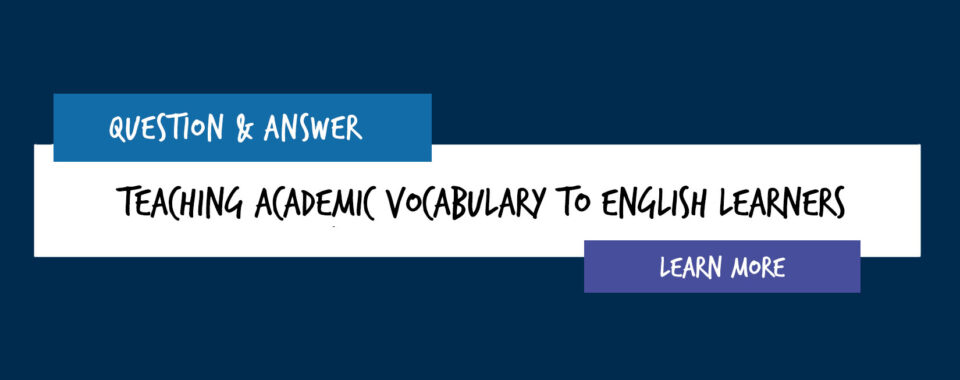
Note: This post first appeared on Education.com June 4, 2018. That piece is titled Teaching Academic Vocabulary to English Learners: A Q&A with Sydney Snyder.
It’s a common scenario when teaching English learners (ELs): The textbook or unit plan comes with a lengthy list of key vocabulary. Should all of them be taught in depth? The risk in trying to tackle all these words is that ELs can end up overwhelmed. Students may memorize definitions rather than actually being able to effectively incorporate new vocabulary into their academic discussions and writing. Also, focusing only on pre-selected vocabulary doesn’t provide ELs with the skills that they need to become more independent learners.
So which vocabulary words should be used to teach ELs, and how should those words be introduced and practiced? Dr. Sydney Snyder, principal associate at SupportEd and co-author of Unlocking English Learners’ Potential, provides the following expert answers for EL educators:
How do I decide which words to teach ELs?
Sydney Snyder: In a synthesis of research-based strategies for teaching academic content to ELs, Scott Baker1 and his panel of researchers recommend teaching a small set of academic vocabulary intensively over the course of several days. This means, in general, that five to eight words, but no more than 10 words, is appropriate. These words should be selected from a short text that aligns to the content being discussed in class. Baker recommends selecting words that:
- Are key to understanding the text and likely unfamiliar to students.
- Are frequently used in the text.
- Are used across disciplines (general academic vocabulary).
- Have multiple meanings.
- Have affixes (prefixes or suffixes).
In order to further narrow down words for intensive focus, it can be helpful to pre-assess student understanding of key vocabulary. You can use pre-assessments to select the priority vocabulary and also as a tool to differentiate new vocabulary lists for ELs of varying proficiency levels. In other words, not all students are going to need practice with the same words. Possible pre-assessment strategies might include:
- Having students do a self-assessment in which they rate their understanding and ability to use new vocabulary (see Figure 1).
- Having students match words and their definitions.
- Asking students to do a word or concept sort. A word or concept sort involves having students sort key terms into categories that either you provide or that they determine on their own. Colorín Colorado provides a video of this strategy in action.2

As you are deciding which words to select for in-depth focus, you can also identify words that you will quickly teach while reading the text with your students. Words for a quick explanation usually:
- Require minimal teaching time.
- Can be taught with a visual, synonym, simple definition, or example.
- Are not essential to understanding the text.
Once you have determined which words you will focus on for in-depth instruction, Diane Staehr Fenner and I recommend using the following framework for vocabulary instruction.3

What are some strategies I can use to introduce new vocabulary?
Sydney Snyder: When introducing new vocabulary, it is important that students have an opportunity to explore new vocabulary in varied ways. It’s essential to provide (or have students write) a student-friendly definition. You don’t want the definition to be more complicated than the word itself, though. The definition should be aligned to the meaning of the word as it is used in the text or the content being learned. Wordsmyth.net4 is one resource for developing student-friendly definitions as this website provides definitions at the beginner, intermediate, and advanced level.
In addition to a simple and accurate definition, you can also consider using visuals, gestures, examples and non-examples, synonyms and antonyms, and translations in home languages. When providing translations, it’s important to remember that even if students are literate in their home languages, they may not understand the meaning of academic words in their home language.
While some academic words can be easily introduced with images and a short definition, more abstract vocabulary may present a challenge for both ELs and non-Els. To support deeper understanding of such vocabulary, you will need to offer students an opportunity to provide examples and non-examples of the word and use the word in authentic discussions. For example, if you were exploring the word justice, you might provide scenarios to students and discuss whether the individuals in the scenario received justice and then ask them to come up with their own scenarios in pairs or small groups. Using a Frayer model can be another effective way to explore abstract vocabulary words and phrases with Els (see Figure 2).

What are some activities that I can use with students to practice new vocabulary?
Sydney Snyder: There is a wide variety of activities to practice new vocabulary with students. ELs should have opportunities to practice new vocabulary using multiple modalities (i.e., speaking, listening, reading, and writing activities). (1)(3)
Games are also an engaging way to review new vocabulary. I have included three vocabulary activities below that are appropriate to use with ELs. As with any activity, it is important to remember that ELs may need additional scaffolding5 depending on their level of language proficiency.
- Word Web: For this activity, students work in small groups. They are provided with a set of key vocabulary on index cards (one word per card) and some pieces of yarn. One student selects two cards and places them on the table with the strand of yarn between them. The student explains the relationship between the two words. The next student selects a new word. He or she can choose any of the previous two words to connect to. This continues until all the words are used. This is a great activity to help students understand the relationship between key concepts. In order to scaffold this activity, you might provide ELs with sentence stems, a glossary of the key vocabulary, or an opportunity to pass on one of their words and select a new word.
- Stronger & Clearer Each Time: This is an oral language activity in which students respond to a content question with three different partners. With each partner, students are asked to make their language stronger (providing greater evidence) and clearer (using more precise academic language). This activity provides an excellent opportunity for students to practice with key academic vocabulary. They have multiple opportunities to hear it used and also use it themselves. You can provide a graphic organizer to use during this activity if needed.6
- Heads Up: This is a fun game in which you write key vocabulary on index cards, one word per card. In pairs, students take turn being the Guesser and the Clue Giver(s). Without looking at the word, the Guesser places an index card on his or her forehead and the Clue Giver tries to explain the word so that the Guesser can figure out the word. The object is to move quickly through the pile of words. For ELs who need more support with this activity, you could provide sentence stems such as “This word means…” or “An example of this word is….” You could also provide a word bank of the vocabulary, so the Guesser has a list to choose from. Another scaffold is to have two people be the Clue Givers.
What strategies should I teach so that my ELs become independent learners of new vocabulary?
Syndey Snyder: In addition to introducing and practicing new vocabulary, it’s also important that your ELs gain strategies for figuring out new words independently. In order to help them develop these skills, you can provide targeted mini-lessons that focus on vocabulary building strategies such as awareness of cognates and false cognates, using context clues, understanding word parts, and identifying words with multiple meanings(1)(3).
Building Awareness of Cognates and False Cognates
Cognates are words in different languages that are derived from the same word of origin or root. In addition to having the same meaning, the two words look and sound similar. For example, the word conclusion in English is conclusión in Spanish. It may seem like students will automatically make these connections, but this is a skill that needs to be explicitly taught and practiced. For example, you might have students complete a bilingual glossary in which they determine whether the new vocabulary words are cognates in their home language or not. It’s also important to teach students to be wary of false cognates or “false friends” as they are sometimes called. These are words that look and sound similar in two languages but actually have very different meanings. For example, the word assist in English means to help, but the phrase assister à in French means to attend an event.
Using Context Clues
Modeling and giving ELs an opportunity to practice determining the meaning of unfamiliar words using clues from the same sentence or surrounding sentences will support them in becoming more independent learners of new vocabulary. During a mini-lesson, a teacher might use a think-aloud to model how he or she uses context clues to determine the meaning of an unfamiliar word. Then students can work in pairs to practice using an activity structured similarly to the one in Figure 3. The students read the sentences that contain the word and the clues, select clues that help them determine the meaning, and write a definition for the word. The teacher can provide the list of unfamiliar words, the location in the text, and the location of the clues.

Understanding Word Parts
ELs will also benefit from explicit instruction of, and practice with, word parts including prefixes, suffixes, and root words as a tool to make predictions about the meaning of unknown words. The teacher can model when reading texts aloud. Then students can practice changing the forms of words that they are studying and explore the implications for the meaning of the word in its different forms. Figure 4 provides an example of a table that students might complete.

Identifying Words with Multiple Meanings
One challenge that ELs might face with new vocabulary is misunderstanding the meaning of a word that has more than one meaning. Social studies and science texts, in particular, are filled with everyday words that have a secondary meaning in the content area (e.g, front, cell, party). You can provide ELs with opportunities to identify words with multiple meaning and determine how the meaning differs from their everyday use. Once you model this and/or provide a mini-lesson in which students can practice differentiating between the meanings of words in texts, you might even turn multiple meaning words into an ongoing challenge. Students can earn prizes for identifying words with multiple meanings in classroom texts.
These strategies for selecting, introducing and practicing vocabulary words can help ELs become independent learners of new vocabulary. Dr. Sydney Snyder is interested in learning what strategies you have found to be particularly effective in introducing and practicing vocabulary in your context. Feel free to reach out to her at Sydney@supported.com.
For more strategies like these, read our Q&A with EL expert Dr. Diane Staehr Fenner on scaffolding instruction for English learners.
Sources:
- Baker, S., Lesaux, N., Jayanthi, M., Dimino, J., Proctor, C. P., Morris, J. & Newman-Gonchar, R. (2014). Teaching academic content and literacy to English learners in elementary and middle school (NCEE 2014-4012). Washington, DC: U.S. Department of Education, Institute for Education Sciences, National Center for Education Evaluation and Regional Assistance. Retrieved from https://ies.ed.gov/ncee/wwc/Docs/PracticeGuide/english_learners_pg_040114.pdf
- Colorín Colorado. (n.d). Using a concept sort with ELLs (video). Retrieved from https://www.colorincolorado.org/video/using-concept-sort-ells
- Staehr Fenner, D. & Snyder, S. (2017). Unlocking English learners’ potential: Strategies for making content accessible. Thousand Oaks, CA: Corwin.
- Wordsmyth.net https://www.wordsmyth.net/
- Education.com (2018). Scaffolding Instruction for English Learners: A Q&A with Diane Staehr Fenner. Retrieved from https://www.education.com/magazine/article/instruction-assessment-for-english-learners/
- Zwiers, J. (2017). Fortifying listening and speaking skills. https://jeffzwiers.org/fortifying-speaking
- August, D., Staehr Fenner, D., & Snyder, S. (2014). Scaffolding instruction for English language learners: A resource guide for ELA. Retrieved from https://www.engageny.org/resource/scaffolding-instruction-english-language-learners-resource-guides-english-language-arts-and
- National Behavior Support Service. (n.d.). Frayer model: Vocabulary strategy. Retrieved from https://www.nbss.ie/sites/default/files/publications/frayer_model_-_vocbulary_strategy_handout__copy_3.pdf



